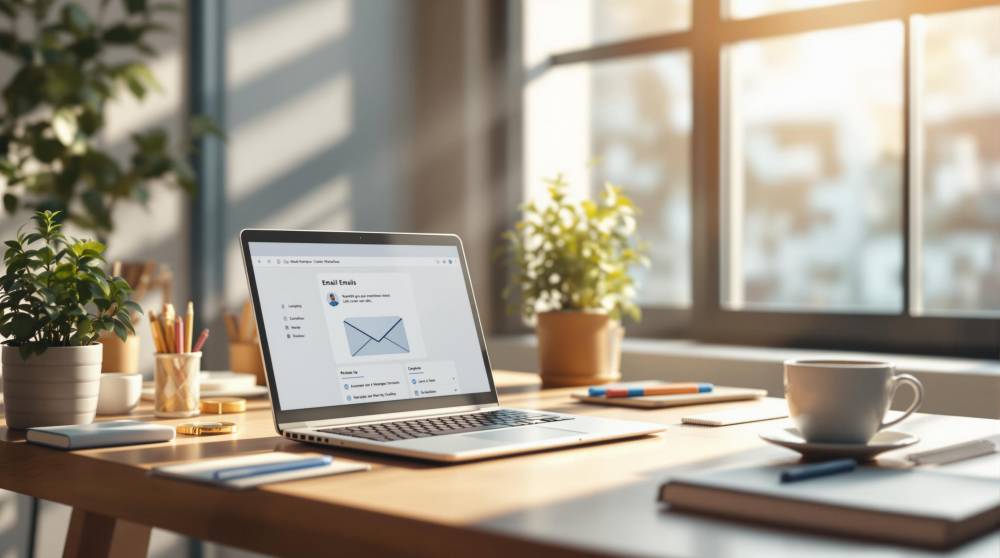5 Essential Email Management Tips for Marketing Professionals 26 min read · Written by Mae R Davis on · Email Protection.


Struggling with email overload? Marketing professionals spend nearly 28% of their week managing emails, losing valuable time on tasks like campaign coordination and client communication. Here's how to fix it:
- Organize Your Inbox: Use folders, filters, and the "Four D's" (Do, Delegate, Defer, Delete) to manage emails efficiently.
- Automate Repetitive Tasks: Leverage tools like HubSpot or Brevo to set up auto-replies, templates, and behavior-triggered emails.
- Secure Your Emails: Protect sensitive data with strong passwords, two-factor authentication, and email encryption.
- Time Your Emails Right: Send emails during peak engagement times (e.g., B2B: Tuesday–Thursday, 9 AM–12 PM EST).
- Write Better Emails: Craft clear subject lines, personalize content, and design professional email signatures.
Quick Comparison of Email Automation Tools:
| Tool | Price | Best For | Key Integration |
|---|---|---|---|
| HubSpot | $50/month | All-in-one marketing | CRM, CMS |
| Brevo | $9/month | Budget-conscious teams | E-commerce platforms |
| Omnisend | $16/month | E-commerce marketing | Online stores |
| ActiveCampaign | $15/month | Advanced automation | CRM systems |
Start managing your inbox smarter today! These strategies will save time, boost productivity, and improve email communication.
Proven Email Management Techniques for Professionals
1. Set Up an Organized Inbox System
Managing a high volume of daily emails is a common challenge for marketing professionals. An organized inbox can help you work more efficiently and respond to campaigns on time.
Create Smart Folders and Rules
Smart folders and automated rules can help turn email chaos into a manageable system. Set up folders that fit your workflow, such as:
- Client or Campaign folders for specific projects
- Project status categories to track progress
- Team communication folders for internal updates
- Newsletter and competitor monitoring folders
Use email filters in tools like Gmail or Outlook to automatically sort emails based on sender, subject line, or other criteria.
For example, in March 2023, Acme Digital used automated email sorting for their client EcoFriendly Products. They created filters based on sender addresses and subject keywords, which cut manual sorting time by 40% and sped up customer response times by 25%.
"On your computer, you can manage your incoming mail using Gmail's filters to send email to a label, or archive, delete, star, or automatically forward your mail." – Gmail Help
Once your inbox is organized, focus on processing emails efficiently.
Handle Each Email Once
Dealing with emails as they come in can save time and reduce inbox clutter. When you open an email, take one of these actions:
- Delete: Get rid of unnecessary messages right away.
- Delegate: Forward emails to the right team member.
- Respond: If it takes less than 2 minutes, reply immediately.
- Defer: Move it to an "Action Required" folder for later.
- Do: Act on urgent tasks immediately.
"If you can read and respond to an email in two minutes, why not take care of it now? It'll save you hassle in the long run. Quick wins can help you feel in control, so don't wait when you don't have to."
To avoid constant distractions, set specific times to check your inbox. Studies show that 68% of workers struggle to find time for focused work due to email interruptions. For emails that require more time, create an "In Process" folder and review it during your scheduled email management blocks.
2. Use Email Automation Tools
Once your inbox is organized, automation can take over repetitive tasks while keeping emails personal. Automated emails drive 37% of email-related sales, even though they make up just 2% of total sends.
Build Auto-Replies and Message Templates
Pre-made responses save time and ensure consistency. Create templates for common scenarios like:
- Campaign updates
- Client onboarding
- Newsletter confirmations
- Meeting scheduling
- Project status reports
Use placeholders for details like names and company information to quickly personalize each message.
For out-of-office replies, keep them professional and clear. Include:
- Exact dates of your absence
- An alternative contact person
- When they can expect a response
- Your professional signature
After setting up templates, connect your email system with marketing tools to improve workflow further.
Connect with Marketing Software
Did you know? 76% of companies rely on marketing automation to simplify their processes.
Here’s a quick comparison of popular email automation platforms:
| Platform | Starting Price | Best For | Key Integration |
|---|---|---|---|
| HubSpot | $50/month | All-in-one marketing | CRM, CMS |
| Brevo | $9/month | Budget-conscious teams | E-commerce platforms |
| Omnisend | $16/month | E-commerce marketing | Online stores |
| ActiveCampaign | $15/month | Advanced automation | CRM systems |
These tools offer features like:
- Behavior-triggered emails with a 5.7% click-through rate
- Automated list cleaning to keep subscriber databases up-to-date
- Detailed analytics for campaign tracking
- Segmentation options for targeted messaging
To get the most out of these tools, integrate them with:
- Customer Relationship Management (CRM) systems
- Content Management Systems (CMS)
- Social media scheduling tools
- Analytics platforms
- E-commerce platforms
"The biggest value of email automation is the ability to deliver relevant emails to the right people at the right time." - Omnisend
sbb-itb-0191afb
3. Keep Your Email Safe and Private
If you're a marketing professional, you're likely handling sensitive data daily. With phishing incidents increasing by a staggering 1,265% and 91% of cyberattacks starting through email, securing your email is non-negotiable.
Strengthen Your Security Measures
Your first defense is a strong password. Aim for at least 16 characters, mixing uppercase and lowercase letters, numbers, and special symbols.
| Security Layer | Implementation | Benefit |
|---|---|---|
| Password Manager | Tools like 1Password, Bitwarden, or Dashlane | Creates and stores unique passwords |
| Two-Factor Authentication | Use an authenticator app or hardware key | Adds protection even if your password is compromised |
| Email Encryption | SSL/TLS protocols | Safeguards sensitive data during transit |
| VPN Service | Enterprise-grade VPN | Secures email access on public networks |
To enhance your security:
- Use unique passwords for every marketing platform.
- Enable multi-factor authentication on all tools.
- Regularly update your email client and security software.
For even better protection, consider specialized tools designed to address specific threats.
Boost Security with Email Monster

After implementing basic security measures, tools like Email Monster can add an extra layer of protection. Starting at just $0.99/month or $6.99/year, Email Monster offers:
- Unlimited email aliases for campaigns.
- Tracking to see if your email was shared or sold.
- Advanced spam prevention with sender blocking.
- Weekly or monthly email digests for better management.
This tool helps keep your primary email address safe while maintaining professional communication.
"I can take your email address and find data you may not have even realized you've given to a brand. The amount of data that is out there on us as consumers is literally shocking." - CEO of an advertising firm in Minneapolis [11]
With 94% of companies facing spear phishing or impersonation attacks in 2022, using temporary email aliases for marketing signups or testing can be a game-changer. Pairing Email Monster's alias system with encryption can help prevent costly data breaches, which now average $4.45 million per incident.
4. Plan Email Timing and Follow-ups
Timing and follow-ups are key to a well-rounded email strategy. When combined with organized inboxes and automation, they can significantly improve your campaign's outcomes.
Pick the Best Send Times
Not all audiences check their email at the same time. Choosing the right time to send can make a big difference. Here’s a quick guide:
| Audience Type | Best Days | Best Times (EST) | Engagement Rate |
|---|---|---|---|
| B2B Marketing | Tuesday–Thursday | 9:00 AM – 12:00 PM | 47.9% [14] |
| B2C Marketing | Friday | 3:00 PM – 7:00 PM | 31% [14] |
| Global Campaigns | Tuesday | 10:00 AM | Highest open rates [15] |
Timing Tips:
- Time zone targeting: Schedule emails for 8:00–10:00 AM in the recipient’s local time.
- Industry-specific timing: B2B emails perform better during work hours; B2C emails do better in the evenings or on weekends [14].
- Day selection: Fridays are great for conversions, while Tuesday through Thursday is ideal for higher open rates [14].
Once you’ve nailed your send times, use tracking tools to fine-tune your follow-up strategy.
Track Responses and Set Reminders
Smart tools can help you monitor responses and plan follow-ups effectively. These tools ensure that your email efforts stay on track and aligned with your goals.
Top Follow-up Tools
Here are some platforms to consider:
| Tool | Key Features | Rating | Starting Price |
|---|---|---|---|
| Saleshandy | Email tracking, Templates | 4.6/5 | $25/month [16] |
| Reply.io | Multichannel campaigns | 4.6/5 | $49/month [16] |
| Instantly | Warm-up tools | 4.8/5 | $30/month [16] |
Real-World Example: In February 2024, Nuffield Health revamped their follow-up process by using personalized landing pages and customized email sequences. This shift helped them increase their conversion rates from 1% to 8% [17].
Pro Tips for Follow-ups:
- Use AI tools to analyze recipient behavior and adjust timing.
- Automate reminders based on engagement metrics.
- Personalize follow-ups using CRM data for better resonance.
- Keep your follow-ups short and focused on delivering value.
Including the recipient’s name in the subject line can increase click-through rates by 22.2%. Similarly, adding one to three questions in your email can make recipients 50% more likely to respond.
5. Write Better Marketing Emails
Once your email systems are secure and well-timed, it’s time to focus on creating content that connects with your audience. Just like your overall email management strategy, your email content should be clear, concise, and engaging.
Improve Your Subject Lines
A good subject line can be the difference between an email that gets opened and one that gets ignored. Use these strategies to make your subject lines stand out:
| Subject Line Element | Impact | Example |
|---|---|---|
| Personalization | Increases open rates by 26% | "Sarah, Your Custom Marketing Report" |
| Short Length (under 50 characters) | Boosts opens by 12% | "Quick Win: 3 Steps to Better SEO" |
| Urgency | Improves opens by 22% | "Last Day: Marketing Summit Early Bird" |
| Numbers/Lists | Leads to 15% more opens | "5 Email Trends Reshaping B2B" |
Tips for crafting subject lines:
- Aim for 6-10 words or 40-60 characters.
- Use action verbs to grab attention, but steer clear of spammy words like "FREE", "Guaranteed", or "Act Now."
Design Professional Email Signatures
Your email signature isn’t just a formality - it’s a chance to promote your brand. A well-crafted signature can achieve an average click-through rate of 4%. Here’s what to include:
- Set dimensions to 300–400px wide by 150–200px high.
- Stick to your brand colors for consistency.
- Add a headshot or company logo (200×200px).
- Include social media icons that link to your profiles.
- Add a clear call-to-action, like “Schedule a Meeting” or “Learn More.”
Writing tips for emails:
- Write in the second person to make it feel personal.
- Highlight benefits rather than features.
- Use a conversational tone while staying professional.
- Break down complex ideas into smaller, easy-to-read sections.
- When relevant, include social proof like testimonials or statistics.
"In my experience in email marketing, you have to tell people what they'll get from reading more. That can be a discount, an offer, or a valuable piece of information they can't get anywhere else."
Conclusion: Next Steps for Better Email Management
Marketing professionals dedicate about 28% of their workweek to emails . To manage this effectively, focus on three core areas: organization, automation, and integration.
Start with building a strong foundation for email organization. Apply the Four D's framework - Do, Delegate, Defer, Delete - to streamline decision-making and handle your daily email load more effectively. This approach reduces decision fatigue and keeps you focused on key priorities. Once your inbox is under control, shift your attention to automation for greater efficiency.
A HubSpot case study from Q3 2023 revealed their marketing team boosted qualified leads by 40% while cutting manual tasks by 25% through automation. Identify repetitive tasks in your workflow and automate them to save time and improve productivity.
| Time Management Strategy | Impact on Productivity |
|---|---|
| Time-blocking for emails | 80% higher task completion rate |
| Email automation | 25% reduction in manual tasks |
"Implementing an email design system with snippets and partials can help you or your team save hours of time. If you already have an email framework or set of templates, you're part of the way there! You can use your templates to create snippets and partials for future email creation."
Finally, integrate your email system with tools like Salesforce or HubSpot to simplify tracking and communication. Use AI tools like Grammarly to ensure polished, professional emails, and explore email management platforms for automated follow-ups.
The average professional handles more than 120 emails daily. Start with one strategy, then layer in others as you go. These steps will help you manage high email volumes and maintain productivity, turning email challenges into streamlined communication.
